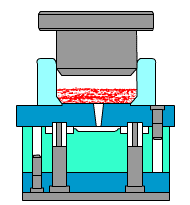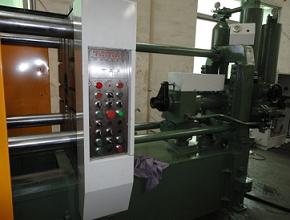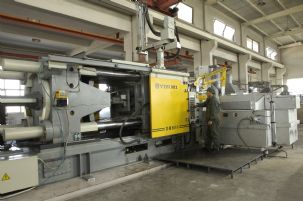What is die casting?
 |
Die casting is a metal casting process by using mould cavity put high pressure on melted metal.Mold is formed by high strength alloys.Most die castings do not contain Fe element,like zinc,copper,aluminum,magnesium,lead,tin,ect.According to different die casting types,we need to use cold chamber die casting machine or hot chamber die casting machine.
History
In 1838, in order to make printing mold, people invented the die-casting equipment. First issued patents related to the die casting is in 1849, it is a small, manual machine to produce printing machine type. In 1885,Otto Mergenthaler invented the Linotype typesetter, this kind of machine can be a whole line die casting into a single type, it brings to the printing industry unprecedented innovation. After the large-scale industrialization of the printing industry, the traditional hand pressure type has been replaced by die casting. Around 1900, typecasting typesetting entered the market,making printing industry automation technology to get further improved, so sometimes more than 10 sets die casting machines could be seen on a newspaper office.With the growing of consumer products, the invention of otto received more and more applications. People can take advantage of die casting to manufacture components in bulk. In 1966, general dynamics invented the speed close die casting technology, this process is sometimes referred to as double punch die casting.
Process
Traditional die casting technology is mainly composed of four steps, or called high pressure die casting. These four steps including mould preparation,filling,injection mould and shakeout.They are also the basis of various modified die-casting process. In preparing process,we need to spray lubricants to cavity of mold, lubricants can help to control the temperature of the mold,but can also help casting mold release.Then you can close the mold, with high-pressure injecting molten metal into the mold.The pressure ranges between 10 to 175 million mpa.After filling molten metal,pressure will remain until the casting solidification.Then push rod will push out all the castings.As there may be multiple mold cavities in a mold, so every time may produce multiple castings during casting process.Shakeout process requires the separation of residue, including gate, runner, gate and flash. This process is usually through a special trimming die extrusion casting. Other methods of doffing including sawing and grinding.
Equipment
 |
 |
| Hot chamber die casting | Cold chamber die casting |
Die casting machine mainly can be divided into two different types,hot chamber die-casting machine and cold chamber die casting machine.The difference is that they can withstand how much power,the typical stress ranges between 400 and 4000 kg.
*Hot chamber die casting
Hot chamber die-casting,sometimes also called gooseneck die-casting, its metal pool is metal molten liquid and semi-liquid metal,these metal will fill mould under the fuction of pressure.At the beginning of the cycle, the piston of machine was contracting,at this time, the molten metal can fill the goose neck. Pneumatic or hydraulic piston squeeze the metal, and fill in the mold.The advantages of the system includes fast circulation speed (about can complete 15 cycles per minute), easy to realize automation operation, at the same time, the metal melting process is also very convenient.Disadvantages include cannot die cast high melting point metal, also can't die casting aluminum, because aluminum will take out iron in the pool. Therefore,usually hot chamber die casting machine is for zinc, tin and lead alloy. Moreover,hot chamber die casting is difficult to used for die casting large castings, this process is usually used to die cast small castings.
*Cold chamber die casting
When metal that could not be used for hot chamber die-casting technology, can be used in a cold chamber die casting, including aluminum, magnesium, copper, and zinc containing a high percentage of aluminum alloy. In this process,the need to a separate crucible to melt the metal.Then a certain amount of molten metal is transferred to an unheated injection room.By hydraulic or mechanical pressure, these metals are injection into mould.Because we need to transfer molten metal into the cold chamber,the biggest drawback of this process is that the cycle time is very long. Cold chamber die casting machine could be divided into vertical and horizontal.Vertical die casting machine is a small machine, however the horizontal die casting machine has various models.
Metals used in die casting
Metals used in die casting include zinc, copper, aluminum, magnesium, lead, tin and lead tin alloy.
*Zinc die castings:Most easy die casted metal.It is very economic to make small parts,easy to coating, high compressive strength, plasticity,long service life.
*Aluminum die castings:Light quality, high dimension stability for manufacturing complex and thin wall castings,strong corrosion resistance,good mechanical performance,high thermal conductivity and electrical conductivity, high strength under high temperature.
*Magnesium die castings:Easy to do machining, high strength weight ratio, is the lightest weight in all die casted metals.
*Copper die castings:High hardness, strong corrosion resistance,best mechanical properties in commonly used die casted metals, wear resistance,strength close to the steel.
Advantages and disadvantages
The advantages of die casting include good size accuracy. Comparing with other casting process(investment casting,sand casting), the casting surface is smooth, rounded corners radius is approximately 1-2.5 microns It can be directly casting internal structure, such as silk, heating element,high strength and bearing surfaces. Other benefits include that it can reduce or avoid the secondary machining, high production speed and the tensile strength could reach 415 million mpa, can casting high liquid metal.
The biggest disadvantage of die casting is high production cost.Casting equipment and mold, mold related components are all expensive compared with other casting method.Therefore die casting production is more suitable for a large number of products. Other disadvantages include: this process applies only to liquid metal and the casting weight must be between 30 grams to 10 kilograms.Usually, die castings in the last batch will always exsit porosity. So can't make any heat treatment or welding, because the gas inside the gap will be expanded under the effect of heat ,leading to micro defects of the internal.


